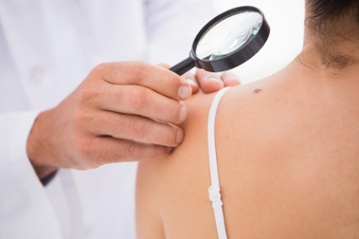May is Melanoma Awareness Month and a perfect time to talk about sun safety and how to protect your skin from the sun’s harmful rays. Sun exposure with ultraviolet light causes damage to your skin. Both significant sun exposure (think even a light pink sun burn) and chronic exposure (normal day to day activity over time) increase your risk for sun damage and skin cancer. Melanoma is the most dangerous form of skin cancer and kills an estimated 10,000 people annually in the United States*. We’ve highlighted 5 things you should know about this disease, according to our expert team.
- Melanoma is not the most common skin cancer. While melanoma is the deadliest form of skin cancer, it is not the most common. There are six types of skin cancers and pre-cancers*. Types of skin cancer vary in their characteristics, their location, their likelihood of spreading, and their appearance in the general population. The most common form is basal cell carcinoma.

- Heredity plays a major role in melanoma. Roughly 1 in 10 patients diagnosed with the disease have a family member with a history of melanoma. It is important to know if there is a history of melanoma in your family tree, so you can be vigilant about skin exams and take extra precaution when in the sun.
- The first step in treatment is to remove the melanoma.The standard method of removing a melanoma is by surgical excision, essentially cutting it out. This procedure is performed under local anesthesia in our dermatology office, although in some instances where the location (eyes, ears, etc) may be challenging, referral to another specialist colleague can be required. Stitches are in place for a period of time and removed in the office.
- Know what to spot during your skin cancer self-exam. Make sure you know the ABCDEs of melanoma and what to look out for:
- Asymmetry: If you draw a line through the middle of a mole and the two halves do not match, this is a warning sign.
- Border: A benign mole has a smooth border, but a melanoma often has an uneven border with variable edges.
- Color: If your mole is a single shade of brown, it is likely benign. Melanomas are often a combination of several colors
- Diameter: Benign moles usually have a smaller diameter. Melanomas are often larger in diameter, think larger diameter than a pencil eraser.
- Evolving: Benign moles usually look the same over time, but you should be vigilant of changing moles.
- It’s crucial to meet with your dermatologist. Self-exams are important, but evaluation by a member of your dermatology team is critical.
Melanoma is treatable if detected early, so make sure you are practicing self-exams and know the warning signs to look out for. Stay tuned to our blog all month for sun safety tips and more on melanoma. In the meantime, schedule a consultation with our team and discuss your family’s history and how you can stay sun-safe.
*Source: The Skin Cancer Foundation www.skincancer.org


Leave a Reply